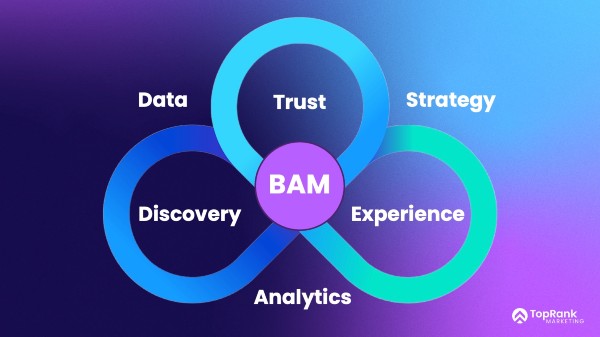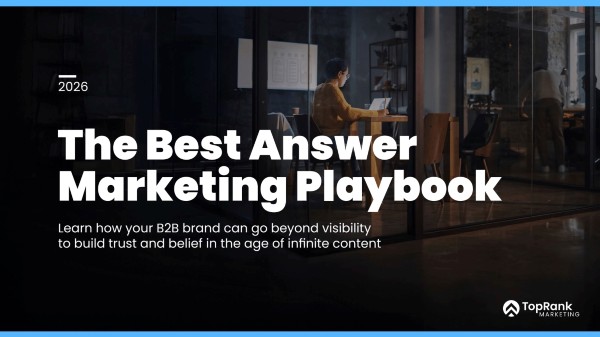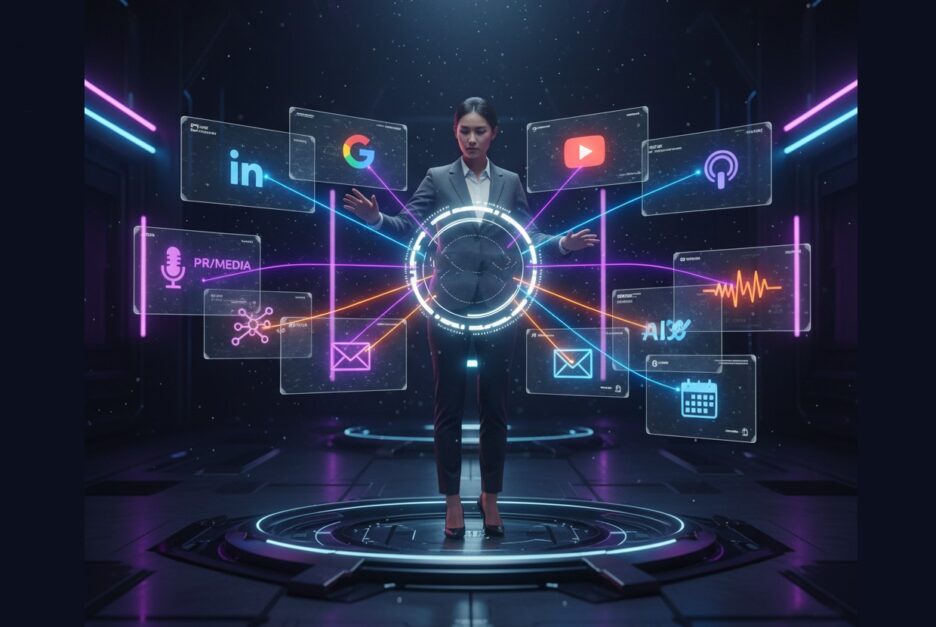Imagine this situation: a B2B tech company creates an amazing video explaining a complex solution. They post it on their YouTube channel, share it on their company LinkedIn page, mention it in an email newsletter and the marketing team does their part to share on their own social channels. The message is solid. The visuals are compelling and the team worked hard on the project.
And yet a few months later, leads are lukewarm, engagement is low, and the response to the video is the sound of crickets.
Situations like this are increasingly familiar. While most B2B marketers have evolved from thinking of content promotion as an afterthought, spend on content development vs. promotion is still unbalanced with some sources indicating a 2 to 1 split.
With the impact of AI and changes in customer behavior in content discovery and consumption, relying on traditional promotion channels like brand social alone is like sending up flares in a storm. It might get attention for a moment, but the ephemeral nature of social media and the changing algorithmic emphasis on what gets shown to your followers doesn’t guarantee you’ll be seen where people are actually looking.
The bottom line is that organic visibility for B2B brands is shrinking AND changing, competition for ad space is rising, and algorithms are favoring signals of trust, novelty, credentials, and shared authority more than ever.
Why multi‑channel content promotion and findability is no longer optional
- According to research from McKinsey, B2B buyers now average 10+ channels of interaction during the buyer journey. Omnichannel expectations are no longer a luxury, they’re expected.
- According to research from HockeyStack, B2B SaaS companies report needing 2,879 impressions and 266 touchpoints to close a deal, up significantly year-over-year. For higher deal sizes ($50K-$100K), that goes past 3,000 impressions and 300+ touchpoints.
- Organic reach on many social platforms has dropped in reach – Instagram has had a 12% year-over-year decrease (Social Insider) and according to the Algorithm InSights 2025 report, a typical LinkedIn company page post is shown to only 1.6% of its followers – a 15% drop from late 2023, for example. B2B brands can no longer rely on promoting content through their own social channels to reach customers.
These stats show two things: one, buyers are seeing brands through many touchpoints across multiple channels. Two, relying on status-quo channels isn’t enough to build trust or be discovered.
What multi‑channel discovery looks like using Best Answer Marketing
Building on the earlier Best Answer Marketing pillars of Data‑Informed clarity, Integrated Strategy, Trust System, and Experiential Content, Multi‑Channel Discovery ensures that your content is findable wherever buyers are doing their research: search, social, media, events, AI tools, industry influencers and so on. It’s about publishing, promoting, and optimizing with intention and distinctiveness.
Here are key considerations for BAM Multi-Channel Discovery:
1. Strategic Publishing & Channel Mix Audits
To be the best answer, B2B brands must tap into earned and partner channels to make sure their narratives travel through the trusted ecosystems that buyers already rely on. This means auditing the current situation for optimization and opportunities to act on:
- Auditing current brand and competitor channels of distribution to understand current situation, uncover gaps, identify opportunities.
- Owned channels (website, blog), email, and social are opportunities for performance optimization.
- Based on audits, new channels for promotion, advertising, partnering and channel extension are added.
2. Search & AI Visibility Optimization
With search and AI tools influencing information discovery in new ways, the BAM system calls for content to be structured, cited, and validated so it consistently surfaces as a credible, high-quality resource – ideal for reference and citation by AI-Overviews and GenAI search. This means:
- Structuring content so it can be pulled into AI Overviews, summaries, and conversational search answers. Use GEO best practices schema, concise answers, strong headers.
- Conduct original research, thought leadership, and earn third‑party citations. Unique data and perspective will matter more than ever as they’re regarded as higher quality inputs in AI summarizations and by customers alike.
- Leveraging Experiential Content on relevant publishing and promotional channels to achieve differentiation and distinction in visibility against competitors.
3. Amplification via Influencers, Earned Media & PR
Trust signals multiply when influencers, media, and PR amplify brand stories which makes them more discoverable and more believable across channels. This means:
- Influencer collaboration and content co-creation that aligns the influencers’s credibility and audience with the appropriate brand topic and buyer stage, helps expose relevant content to the specific audiences in need, can lead to shares, and conversational authority as well as direct buyer engagement.
- Earned media & PR expands visibility and builds trust. Third‑party credibility is more important than ever for people and AI-powered platforms.
4. Experiential Content + Consistent Discovery Signals
Mediocre content with great promotion is not enough to stand out. Distinctive and experiential content formats that achieve visibility across the different channels where buyers can be influenced adds up to the kind of consistency that earns trust and consideration. This means:
- Content formats like video, virtual/in‑person events, and interactive tools draw attention while multi‑channel promotion will ensure that attention extends across the multiple touchpoints buyers are now using to research and source solutions.
- For example, launching a webinar citing original research insights with a distinctive story and aesthetic could be accompanied by teaser videos, influencer endorsements, blog posts, social media stories, targeted event ads on LinkedIn, search ads on Google and email promotions. The distinctive story and visual elements extended across formats and channels make this kind of marketing effort stand out, earn trust and engage in the ways that matter most to modern B2B buyers.
A Use Case: Multi-Channel findability in action
A B2B cybersecurity firm specializing in insider threat prevention wants to engage HR, IT, and Finance leaders-an audience that is increasingly concerned about hybrid work risks and regulatory compliance.
Data-Informed:
Through CRM analysis and customer surveys, the firm learns that its best opportunities are with mid-market enterprises in regulated industries like healthcare and finance. Audience research with tools like SparkToro shows these buyers consume thought leadership via LinkedIn, listen to security podcasts, and subscribe to industry newsletters. SEO analysis (via Semrush, Ahrefs) reveals growing search demand around terms like “insider threat prevention tools,” “hybrid workforce security,” and “compliance automation.” Social listening (via Meltwater, Sprinklr) identifies that respected CISOs and security analysts drive much of the conversation on LinkedIn and at industry events.
Integrated Strategy:
With these insights, the firm builds a narrative framework anchored around “Protecting the People Inside: Insider Threat Prevention for the Hybrid Enterprise.” The content strategy aligns to buyer stages: top-funnel educational content about insider risk trends, mid-funnel resources comparing prevention strategies, and bottom-funnel case studies showing ROI from prevention programs. Business goals (pipeline growth in healthcare and finance) are mapped to these narratives.
Trust System:
To strengthen credibility, the cybersecurity firm commissions original research on insider threat incidents in hybrid workplaces, then co-publishes in partnership with well-known industry analysts. They collaborate with CISOs and compliance experts as influencers, showcasing their perspectives in podcast interviews and drilling down into the research and insights with webinars. Customer advocacy comes through detailed case studies from early adopters in healthcare, validated by third-party analyst and influencer quotes. Earned media outreach ensures findings are covered in trade publications like SC Media and Dark Reading.
Experiential Content:
The firm creates an interactive “Insider Threat Risk Calculator” to help buyers assess vulnerabilities, a live webinar series featuring CISOs discussing prevention strategies, and a video case study series highlighting customer success stories. They also produce a downloadable playbook that combines the research, influencer perspectives, and customer insights into a narrative guide. Each format is designed to engage audiences emotionally through real stories of risk and resolution while providing practical guidance.
Multi-Channel Discovery:
Armed with credible, experiential content and trusted voices, the firm implements a multi-channel discovery strategy:
- Search & AI Visibility: The research report is published as an SEO-optimized Power Page with schema markup, FAQs, and structured takeaways to improve visibility in Google search and AI Overviews. Content is designed for citation by AI models like ChatGPT through unique data points and media coverage.
- Influencer & Earned Media Amplification: Influencers share key insights on LinkedIn, in newsletters, and on podcasts, ensuring the research appears where buyers are already listening. Media coverage in respected outlets further validates the firm’s authority.
- Repurposing Across Channels: Webinar recordings are edited into short LinkedIn video clips, key quotes are designed into graphics for social, and the calculator results drive personalized follow-up emails.
- Omni-Channel Promotion: The firm promotes the playbook and calculator via LinkedIn ads, email campaigns to segmented audiences, and targeted placements in industry newsletters.
- Ongoing Optimization: Using analytics, the firm tracks which channels (LinkedIn influencer mentions, newsletter placements, organic search, or PR pickups) generate the most impressions, AI citations, and pipeline opportunities, and adjusts investments accordingly.
As you can see, by integrating all five pillars, the cybersecurity firm ensures that wherever buyers are looking, they encounter a consistent, credible brand solution story that reinforces both discovery and trust.
Upgrade Your Findability with AI Search
The content visibility multiplier effect
When you combine trusted, experiential content with multi-channel visibility, the results aren’t just additive, they multiply and here’s why: Trust multiplies engagement: content with credibility spreads more, gets shared more, and is more likely to be cited. Experiential formats enhance mental availability, emotional connection and buyability, ensuring buyers don’t just see your brand once, but remember it. Multi-channel availability increases repetition and exposure which are crucial for recall and decision making. Together, these factors make content not only discoverable but also impactful across the entire customer journey.
Multi-Channel findability best practices
As a summary, to compete in today’s hyper competitive and AI-powered information discovery environment, B2B marketers must think beyond isolated posts and stand-alone paid campaigns. Content must appears both the algorithms and the trusted sources of influence that have buyer attention. For your go forward content promotion efforts, consider these Multi-Channel Discovery best practices :
- Broaden your promotional mix: Go beyond owned social and paid ads. Expand your channel strategy to ensure content appears consistently, with distinctiveness and trust across the platforms your buyers use.
- Amplify experiential content: Make sure formats like video, events, and interactive tools are promoted through multiple avenues to maximize exposure and engagement.
- Leverage earned media, influencer collaborations, and PR: These add credibility while extending reach into trusted third-party networks.
- Optimize for AI-powered and traditional search: Content discovery isn’t just about push. Buyers can pull themselves to your brand and solutions if you’re optimized correctly. Structure content so it can be cited, surfaced, and discovered in emerging AI-powered search experiences as well as conventional SERPs.
- Take a data-informed approach: Track which channels generate real visibility and engagement, then refine your strategy to focus on those delivering the best impact.
Best Answer Marketing is a system B2B marketers can grow with

The Best Answer Marketing Framework is made up of 6 pillars that work together to ensure your brand is the most trusted, findable and memorable where buyers are looking from LLMs to search engines to social networks, amongst influencers and industry media.
Pillar 1: Data Informed
Pillar 2: Integrated Strategy
Pillar 3: Trust System
Pillar 4: Experiential Content
Pillar 5: Multi-Channel Discovery
Pillar 6: Unified Analytics
In our next post in the Best Answer Marketing Playbook series, we’ll dive into Pillar 6: Unified, Full Funnel Analytics which is how to measure what content you produce, how you amplify it and whether it’s creating movement across the entire funnel: awareness, consideration, and conversion.

To get a PDF copy of the Best Answer Marketing Playbook, sign up below and we’ll send you a copy including best practices, research data, case studies, and a strategy checklist. PLUS access to our State of B2B Thought Leadership in 2026 Report.



